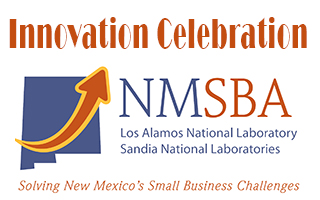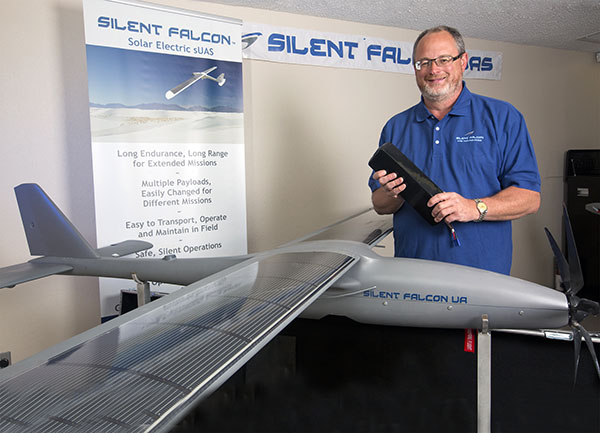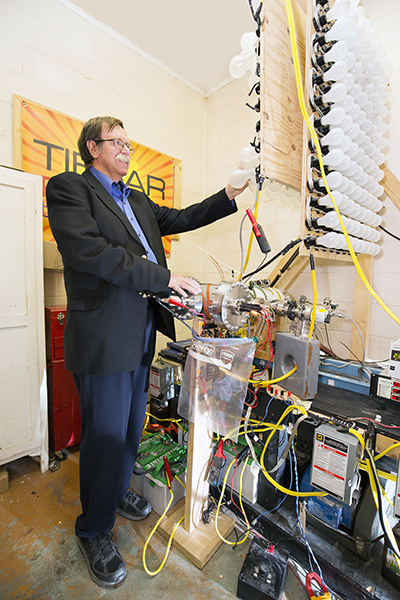Small companies grow with a technical leg up
NMSBA program links national labs, small businesses

Imagine driving a car down the highway with no fuel gauge and no idea how big the gas tank is. You want to go as far as possible before filling up but not so far that you sputter to a halt. “That’s what it’s like to operate an electric plane or robot or other device that relies on a lithium battery,” says Albuquerque businessman Greg Walker. “I wanted a technology to show how much power such a battery has at any particular time.”
Walker is the chief operating officer of Silent Falcon UAS Technologies Inc., which makes electric-powered drone aircraft. The company found four other small New Mexico businesses that use battery technology in everything from robots to motion picture filming. They joined forces to develop a technology to monitor the health of battery packs for all kinds of unmanned vehicles. “Lithium batteries in aircraft and robots are big,” Walker says. “Our challenge was to push the battery as far as possible but not crash.”

DRONE TECHNOLOGY − Dave Walker, chief operating officer of Silent Falcon UAS Technologies Inc. of Albuquerque, worked with a team of Sandians on smart battery software, hardware, programming, and chemistry for his company’s electric-powered drones. “No single company has all the expertise,” Walker says. “Sandia has all the disciplines in one place.” (Photo by Norman Johnson)
The group needed help and reached out to the New Mexico Small Business Assistance (NMSBA) Program, a public-private partnership among Sandia, Los Alamos National Laboratory, and the state of New Mexico that connects small business owners with scientists and engineers who provide technical assistance.
They were teamed with Sandia electrical engineer Von Trullinger (5335) and materials scientist Dan Weskolowski (2545) who, during the past year and a half, have improved the monitoring electronics and algorithms embedded in the battery hardware. They also advanced software designed to communicate with device operators through a web page or Ethernet connection. Users can now monitor battery condition and historical data, and plan even more complicated missions.
The companies, which have received $2 million in new investment and added nine employees since working with Von and Dan, were among 366 small businesses in 24 counties that participated during 2015 in NMSBA. The program also contracts with the New Mexico Manufacturing Extension Partnership, University of New Mexico (UNM) School of Engineering, and the Management of Technology program at the Anderson School of Management, Arrowhead Center at New Mexico State University (NMSU), and the New Mexico Tech Department of Management. NMSBA provided $4.77 million worth of assistance to New Mexico small businesses in 2015.
Ten projects that achieved outstanding innovations through the program in 2015 were honored last month at NMSBA’s annual Innovation Celebration Awards event at Sandia Golf Club.
Silent Falcon’s Smart Battery Manager, along with Tibbar Plasma Technologies, received the Honorable Speaker Ben Luján Award for Small Business Excellence as the honorees that demonstrated the most economic impact.
“NMSBA has been bringing small businesses together with scientists and engineers from Sandia and Los Alamos national laboratories for more than 15 years. This is a phenomenal way to assist small companies that don’t have the resources to do advanced research and development,” says Jackie Kerby Moore, manager of Technology and Economic Development Dept. 1933. “National laboratory expertise helps these business people realize their dreams, and stimulates our state’s economy.”
A market for unmanned vehicles
The global market for unmanned vehicles was $2.29 billion in 2015 and is estimated to reach $4 billion by 2020. Silent Falcon and four companies in a small-business cluster at the Alamogordo Science and Technology Park want to capture a piece of that market by developing advanced unmanned mobile robots.
Two of the companies, Emerging Technology Ventures Inc. and North Alabama Robotic Systems Inc., make unmanned vehicles for land, air, and sea. Motion Picture Marine Inc. uses unmanned vehicles to create sequences for motion pictures like X-Men, Armageddon, and Star Trek. American Lithium Energy Corp. makes lithium-ion batteries that power unmanned vehicles.
Walker says the battery management technology would not have been possible without the help of a Sandia team assembled by Von working in software, hardware, programming, and battery chemistry. “The first year was about getting the hardware together and building circuits,” Walker says. “This year we’re looking at what breaks a battery. How healthy is it? How do you know when a battery is being worn out?”
Walker says the Smart Battery Manager is being used by other partners and will be in place in his company’s planes later this year. “Everything about the technology is getting better,” he says.

TRANSFORMERS − Richard Nebel, president of Tibbar Plasma Technologies Inc., worked with Los Alamos National Laboratory to develop plasma-based AC-DC transformers that can significantly cut the cost of transmitting electrical power. The Los Alamos company has hired 10 new people and completed machine development to manufacture the transformers. (Photo by Sandra Valdez, LANL)
Powerful transformers
Tibbar Plasma Technologies Inc., the other Ben Luján Award winner, worked with Los Alamos National Laboratory’s Juan Fernandez to develop plasma-based AC-DC transformers that can significantly cut the cost of transmitting electrical power. The technology also allows electricity to be transmitted over long distances, as far as 1,200 miles compared to the current maximum of 400 miles.
Tibbar in 2015 received a $3.5 million contract from the DOE Advanced Research Projects Agency-Energy. The Los Alamos company has hired 10 new people and completed machine development to manufacture the transformers.
Projects recognized at celebration
Here are some other projects recognized at the Innovation Celebration:
- IR Dynamics of Santa Fe worked with Sandia to develop thermochromic materials for control of infrared transmission that could be used as pigment additives for smart windows or pigment-based coatings in architecture, transportation, and clothing. Company President William Kurtz worked with Sandia’s Raegan Johnson (1816), Nelson Bell (1815), and Paul Clem (1353) to determine the feasibility of manufacturing such coatings. IR Dynamics subsequently raised $600,000 in private equity funding, secured $100,000 in grants, and got a $1.95 million DOE grant.
- David Cook worked in supply chain operations for 15 years and watched hundreds of businesses try to solve inventory challenges with spreadsheets. He founded Right Sized Inventory to create a computer-driven analysis platform that would let users identify and maintain an optimal amount of inventory for any item in any location. Sandia’s Andy Scholand (5792) made the software more accurate and dependable, allowing customers to refine their inventory analysis. The Albuquerque company has boosted revenues by $50,000 since rolling out the improved software.
- bioLime has developed a modern version of lime-based structural coatings, or “breathable skin,” that make modern buildings more energy efficient, healthier, and longer lasting. Brian Cola, founder and president of bioLime, moved the company from Florida to Santa Fe and, through NMSBA, worked with Scott Bryant of the New Mexico Manufacturing Extension Partnership to identify raw materials and techniques to manage its domestic partners and regional supply chain, saving about $25 million in investment costs.
- Luke Smith was an undergraduate accounting student at NMSU when he founded EcoSeal to bring NMX, an environmentally friendly pesticide, to market. Realizing NMX had to be validated in the field to get regulatory approval, he worked with Griselda Martinez of NMSU’s Arrowhead Center and the university’s Ryan Goss to test the product on turf grass. The work led to a $50,000 I-Corps grant to do more market research to commercialize NMX.
- Innobright Technologies of Albuquerque has developed a software package that changes the cost, time, and quality of computer-generated imagery, or CGI. Innobright’s Altus software runs 10 times faster than conventional rendering programs and provides high-quality images by applying its patented noise-removal algorithms. Owner Raghu Kopalle worked with Steve Walsh of the UNM Management of Technology program to identify the best markets for the product. Kopalle has since raised $330,000, attracted customers from around the world, and hired six people.
NMSBA launched 16 years ago
NMSBA was created in 2000 by the state legislature to bring national laboratory technology and expertise to small businesses in New Mexico, promoting economic development with an emphasis on rural areas. Since its inception, the program has provided 2,495 small businesses in all 33 New Mexico counties with more than $48.5 million worth of research hours and materials. The program has helped create and retain 4,863 New Mexico jobs at an average salary of $38,768, increase small companies’ revenues by $236.2 million and decrease their operating costs by $104.7 million. These companies have invested $97.6 million in other New Mexico goods and services, and received $87.2 million in new funding and financing.
“The small businesses in our group could not have pulled together a team like Sandia did to work on the Smart Battery Manager,” Walker says. “No single company has all the expertise. Sandia has all the disciplines in one place. I am a huge fan of NMSBA.”
Click here for more information on Sandia technology partnerships.